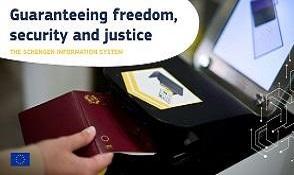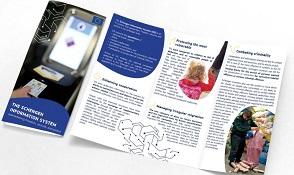An alert entered in SIS by one country becomes available in real time in all other countries that use SIS, so that competent authorities across the EU can find the alert.
Technically, SIS consists of the following components:
- a central system
- national SIS systems in all the countries using SIS
- a network between the systems
Each country that uses SIS is responsible for setting up, operating and maintaining its national system and structures. The European Commission is responsible for general supervision, evaluating the system, and adopting implementing and delegated acts on how the SIS and SIRENE work. The EU Agency for large-scale IT systems (eu-LISA) is responsible for the operational management of the central system and the network.
Countries using SIS
SIS is operational in most EU countries and the Schengen associated countries (Switzerland, Norway, Liechtenstein and Iceland).
Functionalities of SIS, as of 2023
Sharing information
New categories of alerts and more data are shared through SIS, ensuring that more complete and more reliable information is available to the authorities in countries that use SIS.
Biometrics
From March 2023, SIS contains the following types of biometrics to confirm and verify the identity of people registered in the system:
- photographs
- palm prints
- fingerprints
- fingermarks
- palmmarks
- DNA records (only in relation to missing persons)
Fingerprints, palm prints, fingermarks and palmmarks are used for biometric searches through the automated fingerprint identification system in SIS.
SIS does not yet use photograph and facial image recognition technology. The Commission must provide a report on the availability, readiness and reliability of such technology before this can be put in place. The European Parliament will be consulted on the report. Once this technology is put in place in SIS, countries will be able to use these tools at regular border crossing points. After that, the Commission may adopt delegated acts determining other circumstances in which photographs and facial images may be used to identify persons.
Counter-terrorism
More information is being shared on people and objects involved in terrorism-related activities, allowing national authorities to better pursue and prevent serious crimes and terrorism.
Since March 2021, countries have shared search “matches” on SIS alerts related to terrorist offences with Europol. Europol exchanges supplementary information with countries on SIS alerts related to terrorist offences through the SIRENE Bureaux.
Vulnerable persons
Competent authorities can issue alerts on missing persons that include additional data. They can also enter preventive alerts in the system to protect certain categories of vulnerable persons (children at risk of abduction or potential victims of terrorism, trafficking in human beings, gender-based violence, or armed conflict/hostilities).
Irregular migration
Return decisions are part of the information shared in the system to improve the effective enforcement of these decisions. Countries must enter alerts for refusal of entry or stay on people found to be staying in the EU illegally who are subject to entry bans issued in line with the Returns Directive.
Cooperation between registration authorities extended to boat, aircraft and firearms registration
National services responsible for the registration of boats, aircraft and firearms may consult SIS in order to check the legal status of objects presented to them for registration.
- Boat registration services only have access to SIS alerts on boats and boat engines.
- Aircraft registration services only have access to alerts on aircraft and aircraft engines.
- Firearms registration services only have access to alerts for arrest for surrender or extradition, alerts for discreet, inquiry and specific checks and alerts on firearms for seizure or use as evidence.
Enhanced access for EU Agencies
Europol has access to all alert categories in SIS and exchanges supplementary information with countries on alerts related to crimes within its remit. The implementation of the access of European Border and Coast Guard Agency operational teams to SIS is ongoing.
Other updates in the pipeline
On 6 July 2022, the European Parliament and the Council adopted a new regulation enabling Europol to propose that EU countries enter alerts on suspected terrorists and criminals in SIS on the basis of information from non-EU countries. The regulation entered in force on 1 August 2022. The implementation of this new feature is ongoing.
Timeline for changes to SIS
- March 2023
Renewed SIS was launched and became fully operational.
- December 2018
The regulations entered into force on 28 December 2018.
- November 2018
The three proposed regulations from 2016 were adopted:
- Regulation (UE) 2018/1860 on the use of the Schengen Information System for the return of illegally staying third-country nationals
- Regulation (UE) 2018/1861 on the establishment, operation and use of the Schengen Information System (SIS) border checks
- Regulation (UE) 2018/1862 on the establishment, operation and use of the Schengen Information System (SIS) in the field of police cooperation and judicial cooperation in criminal matters
- December 2016
The Commission presented three proposals for regulations to improve and extend the use of SIS, covering the establishment, operation and use of the system for:
- border management
- police cooperation and judicial cooperation in criminal matters
- the return of illegally staying third country nationals
SIS alerts and rights of the individual
A SIS alert contains information about a particular person or object together with instructions for the authorities on what to do when the person or object has been found.
The specialised national SIRENE Bureaux located in each country serve as single points of contact for exchanging additional information and coordinating activities related to SIS alerts.
All data subjects have a right to:
- access data relating to them
- correct inaccurate data or erase data unlawfully stored in the system
Anyone who is the subject of alerts for returns or alerts for refusal of entry and stay has the right to be informed about the alert.
All data subjects have a right to bring proceedings before the courts or competent authorities to access, correct or delete data or to obtain compensation for damages suffered from breaches of data protection law in any of the countries that use SIS.
Related documents
- Regulation (UE) 2018/1860 on the use of the Schengen Information System for the return of illegally staying third-country nationals
- Regulation (UE) 2018/1861 on the establishment, operation and use of the Schengen Information System (SIS) border checks
- Regulation (UE) 2018/1862 on the establishment, operation and use of the Schengen Information System (SIS) in the field of police cooperation and judicial cooperation in criminal matters

- Обновена ШИС — представяне
- SIS renovado — presentación
- Obnovený SIS – prezentace
- Fornyet SIS — præsentation
- Erneuertes SIS – Präsentation
- Uuendatud SIS – tutvustus
- Ανανεωμένο SIS - παρουσίαση
- Nouveau SIS — présentation
- SIS athnuaite — cur i láthair
- Obnovljeni SIS – prezentacija
- Nuovo SIS — presentazione
- Atjaunināta SIS — iepazīstināšana ar
- Atnaujinta SIS - pristatymas
- Megújított SIS – prezentáció
- SIS imġedda — preżentazzjoni
- Vernieuwd SIS — presentatie
- Odnowiony SIS – prezentacja
- SIS renovado — apresentação
- SIS reînnoit – prezentare
- Obnovený SIS – prezentácia
- Prenovljen SIS – predstavitev
- Uudistettu SIS-järjestelmä – esittely
- Förnyat SIS – presentation

- Обновена ШИС — цифрова брошура
- SIS renovado — folleto digital
- Obnovený SIS – digitální leták
- Fornyet SIS — digital folder
- Erneuertes SIS – Digitales Faltblatt
- Uuendatud SIS – digitaalne teabeleht
- Ανανεωμένο SIS - φυλλάδιο σε ψηφιακή μορφή
- Nouveau SIS — dépliant numérique
- SIS Athnuaite — bileog dhigiteach
- Obnovljeni SIS – digitalna brošura
- Nuovo SIS — opuscolo digitale
- Atjaunināta SIS — digitāls buklets
- Atnaujinta SIS - skaitmeninė lankstinukas
- Megújított SIS – digitális brosúra
- SIS imġedda — fuljett diġitali
- Vernieuwd SIS — digitale brochure
- Odnowiony SIS – ulotka cyfrowa
- SIS renovado — folheto digital
- SIS reînnoit – broșură digitală
- Obnovený SIS – digitálny leták
- Prenovljen SIS – digitalna letaka
- Uudistettu SIS – digitaalinen esite
- Förnyat SIS – digital broschyr
